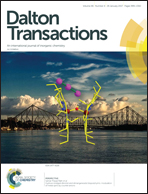New metal chalcogenides found in MnN−1(Gd2−xInx)SN+2 (N = 3, 4, 5): syntheses, structures, and magnetic properties†
Abstract
Three new metal chalcogenides have been identified in MnN−1(Gd2−xInx)SN+2 with N = 3, 4, and 5 via a flux-growth synthesis. All compounds crystallize in the same space group of orthorhombic Cmcm with cell constants: Mn2GdInS5 (1), a = 3.789(1) Å, b = 12.411(1) Å, and c = 15.489(1) Å; Mn3Gd2S6 (2), a = 3.778(1) Å, b = 12.505(2) Å, and c = 19.114(2) Å; Mn4Gd2S7 (3), a = 3.769(1) Å, b = 12.466(2) Å, and c = 22.289(3) Å. Compounds 1–3 form a homologous series through the modulation of the MnS unit, whose structures represent a complete system of the corresponding lillianites (N1,N2L) of 3,3L, 4,4L and 5,5L. The gradually wider slabs formed in the series result in a monotonic increase along the c dimensions from 1 to 3. Crystal 3 is the first to achieve a predicted structure of 5,5L. Mn2GdInS5 (1) displays a weak antiferromagnetic (AFM) ordering at 10 K and the Weiss constant (θ) of −0.76 K. Mn2Gd1.5In0.5S5 (1a), an isostructure of 1, shifts the AFM transition temperature to 12 K and possesses a slightly larger θ constant of −6.06 K. Mn4Gd2S7 (3), featuring the thickest slabs in this series, shows a significant antiferromagnetic behavior beginning at a high temperature of 70 K and has a largest θ constant of −40.25 K. A small amount of impurity α-Gd2S3 with an AFM transition temperature around 4 K was characterized in sample 3, which does not interfere with the magnetic ordering of 3 at much higher temperatures. These magnetic chalcogenides display band gaps of 1.66 eV for 1, 1.75 eV for 1a, and 1.44 eV for 3.



 Please wait while we load your content...
Please wait while we load your content...